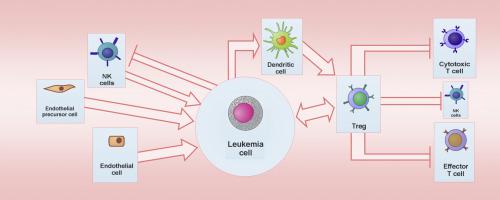Clinical Immunology ( IF 4.5 ) Pub Date : 2020-05-31 , DOI: 10.1016/j.clim.2020.108489 Kendi Nishino Miyamoto 1 , Diego Bonatto 2

|
Acute myelogenous leukemia (AML) is an aggressive hematological malignancy associated with high rates of mortality. This incidence is due to the complexity in which the AML cells interact with other healthy human cells. These phenomena create an environment that favors the expansion of leukemic cells, which will affect the patient's prognosis. An important aspect is the ability of AML cells to evade immune responses via targeting and signaling immune cells to suppress anti-tumor responses. Many studies have reported that associations among components in the peripheral bloodstream might modulate leukemic progression because AML survival is a fundamental step for recolonizing bone marrow after allogeneic hematopoietic stem cell (HSC) transplantation or chemotherapy. Therefore, we collected the most important data about components that circulate with leukemic blasts and contribute to their survival and proliferation. We also discuss clinical approaches that could be conducted to more effectively treat the disease.
中文翻译:

急性骨髓性白血病中的循环细胞和外泌体及其在疾病进展和生存中的作用。
急性骨髓性白血病(AML)是一种与高死亡率相关的侵袭性血液恶性肿瘤。这种发生是由于AML细胞与其他健康人类细胞相互作用的复杂性。这些现象创造了有利于白血病细胞扩增的环境,这将影响患者的预后。一个重要方面是AML细胞通过靶向免疫细胞并向其发出信号来抑制抗肿瘤反应来逃避免疫反应的能力。许多研究报告说,外周血成分之间的关联可能会调节白血病的进程,因为AML存活是异基因造血干细胞(HSC)移植或化疗后重新定殖骨髓的基本步骤。因此,我们收集了与白血病细胞一起循环并有助于其存活和增殖的成分的最重要数据。我们还将讨论可以进行更有效地治疗该疾病的临床方法。











































 京公网安备 11010802027423号
京公网安备 11010802027423号